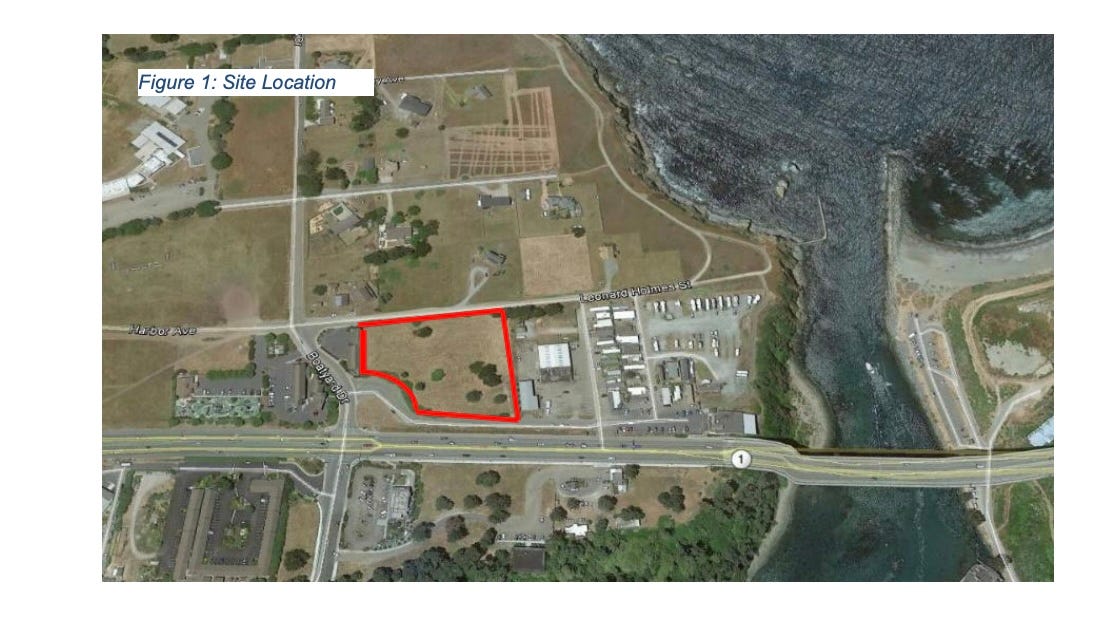Coastal Commission Upholds Fort Bragg’s Approval of 83-Unit Mixed-Use Development
Main Street project cleared to move forward.
The California Coastal Commission on Wednesday approved a new 83-unit mixed-use development on Main Street in Fort Bragg, affirming the City Council’s decision despite multiple appeals citing concerns about the project’s scale, environmental impact and consistency with local coastal plans.
The Commission issued a “no substantial issue determination” on the appeals, meaning Fort Bragg’s amended permit for the project at 1151 South Main St. is now final and effective.
The project, developed by Akoshdeep “Kosh” Grewal of Kosh Petroleum, sits on a 2.6-acre vacant lot on the west side of State Highway 1, just south of the Noyo River Bridge. Initially approved for 87 units, the plan was reduced to 83 residential units across seven apartment buildings ranging from 32 to 38 feet tall. Eight of the units are designated as affordable housing for very low-income households.
To meet mixed-use requirements in the Highway Visitor Commercial (CH) zone, the development also includes a 1,000-square-foot commercial/retail space and four visitor-serving hotel suites without kitchens. One suite will be offered at a low-cost rate and managed by Grewal’s adjacent Emerald Dolphin Inn. Additional features include a 107-space parking lot, an outdoor play area, landscaping, a 5-foot sound wall along Harbor Avenue, and a public access path with signage to Pomo Bluffs Park.
Controversy and Appeals
The development has been described as Fort Bragg’s “biggest new project of the 21st century.” The City Council first approved it on March 24, 2025, subject to 37 special conditions. Councilmember Scott Hockett recused himself due to a financial interest in nearby property.
Seven appeals were filed with the Coastal Commission by individuals and groups, including Paul Clark, Judy Mashhour-Azad, Guy R. Burnett, Mary Chamberlin, Teresa and David Skarr, Annemarie Weibel and Hamid Zarrabi. The appeals prompted the council to issue an amended permit on July 14, 2025, intended to address some of the concerns.
Key issues raised included:
Visual resources: Residents argued the 38-foot height was inconsistent with Fort Bragg’s rural character and obstructed public views. Some criticized the city for not requiring story poles to help the public understand the project’s actual size.
Traffic and public access: Appellants cited inadequate mitigation, an outdated traffic study and risks to coastal access.
Water quality and hydrology: Concerns included unsealed bore holes from past site investigations and reliance on an outdated groundwater report, an unknown impact on the Todd Point aquifer.
Land-use and zoning: Opponents said the project puts private residential units over visitor-serving uses in a zone where the latter are prioritized.
Process and transparency: Critics alleged a flawed noise study, poor noticing of hearings and improper CEQA exemptions. The Commission deemed these “invalid contentions” because they did not directly allege inconsistencies with the Local Coastal Program (LCP).
Commission’s Findings
Despite the breadth of the appeals, Coastal Commission staff recommended a no substantial issue determination, finding “a high degree of legal and factual support” for the city’s approval.
Their reasoning emphasized:
Affordable housing: Eight affordable units qualified the project for state density bonuses, allowing increased building height and reduced requirements for ground-floor visitor-serving uses.
Visitor-serving balance: The inclusion of retail space, four hotel suites (including one low-cost unit) and a public path to Pomo Bluffs Park aligned with the intent of the CH zone.
Visual resources: The site is not designated as a potential scenic view area. Existing development and vegetation already limit ocean views, and landscaping was found to minimize visual impacts.
Traffic mitigation: The project’s traffic was deemed insufficient to reduce service levels below acceptable thresholds. Caltrans did not require a new study. Conditions included signage, street improvements and a possible transit or school bus stop.
Water quality protections: Conditions required stormwater capture in cisterns, bioswales and underground pipes to reduce runoff, as well as a Water Quality Management Plan, trash capture devices and infrastructure upgrades to offset demand.



